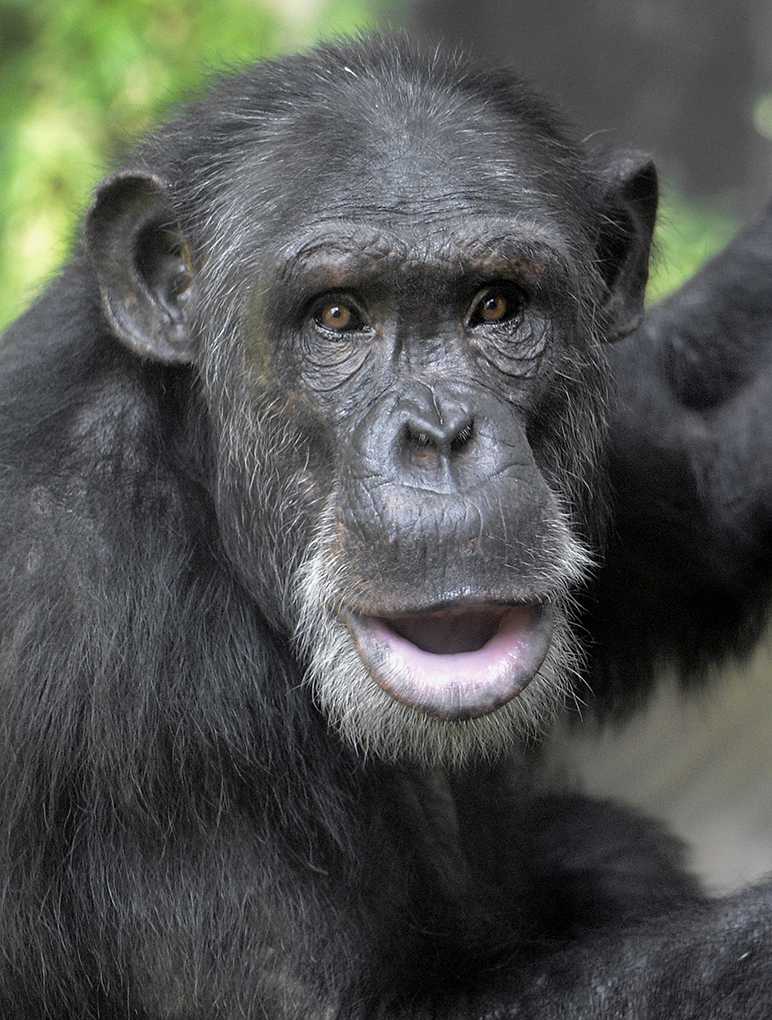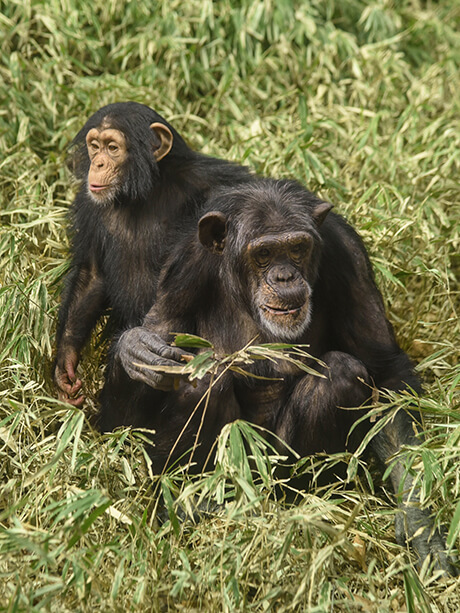The term “fission-fusion” was first used by the pioneering Swiss primatologist Hans Kummer to describe the social behavior of Hamadryas baboons, which he followed dawn to dusk through the arid hills and desert of northern Ethiopia during the late 1960s. Concurrently, thousands of miles to the south, Jane Goodall was living with chimpanzees in the Tanzanian rainforest. Over ensuing decades, she would come to learn more about the behavior of our closest primate cousin than anyone prior or since. She, too, would use the term “fission-fusion” (although inverted) to describe their society.
“The chimpanzee community is a fusion-fission society,” she would write in The Chimpanzees of Gombe. Chimpanzees form large, hierarchical groups, or communities (a fusion of chimps), but within each community exist smaller social groups whose members often change (a fission of chimps). The fluidity of the smaller groups means that individual chimpanzees are “free at almost all times to join – or avoid – any other individual” in the community, wrote Goodall. Choice is inherent in a fission-fusion society, as is change. “It is never possible for a chimpanzee, upon wakening in the morning,” observed Goodall, “to be quite sure who he will encounter during the day.”
Since 2019, the chimpanzees at the Maryland Zoo (MZ) have been experiencing their own version of fission-fusion. Rather than being always together in one group, MZ’s 15 chimpanzees form sub-groups each day that vary by number, size, and composition. Choice and change are also inherent – but not boundless – in their socializing.
“The chimps have choice, but managed choice,” explains Pam Carter, who leads MZ’s chimpanzee program and also serves on the Steering Committee of the AZA’s Chimpanzee SSP. “We can’t let certain chimps choose to be together for behavioral reasons, so we offer them other options.”
Negotiate the Plan
Every morning, Carter and her seven-keeper team meet in their office inside MZ’s Chimpanzee Forest to review the morning plan. They put careful and strategic thought into daily groupings and head off to implement. And then the negotiations begin.
“Chimps are highly intelligent and socially complex animals,” says Carter. “They have their reasons for why our plan might not be a good one, so instead of getting frustrated, we work with them. I think the most important element for any facility wanting to institute this management strategy is to have staff that are willing to learn, be flexible, and be patient.”
With her current team, she has more than that; she has true chimp enthusiasts. “Since working with this troop, I have no desire to go anywhere else,” says Erin Dombroskie, an eight-year veteran of the team. “There are no two days alike with these guys. It’s constantly stimulating. I would describe the end of each day as positive exhaustion.”
“It takes a specific type of person to thrive on the challenges that chimps present,” adds Melissa Somogyi, another team member, “but once you find that niche, none of us would ever want to change that.”
Apart from a committed and experienced staff, fission-fusion within a zoo setting requires appropriate physical infrastructure. It comes down to spaces and doors. At MZ, chimpanzees can make use of two large, enclosed areas – an indoor day room and an outdoor yard – as well as behind-the-scenes dens to settle into two or more groups each day. MZ also has enough doors and chutes to coordinate the sometimes complex shifting of animals between spaces.

Listen and Learn
Understanding who will go where each day is based partly on planning and largely on cues – subtle or crystal clear – that the chimpanzees deliver.
“After doing this for a while, you start to read their choices,” says Carter. “Sometimes they’ll take a look around and just decide not to go. Sometimes they’ll glance over at the group they want to be with. Sometimes one chimp will pull on a door, either to open or close it, to show where it wants to go or who it wants to keep out.”
Keepers take all of this into account as they institute the morning shuffle, with particular attention given to the order in which individual chimps enter a space. Given the complexity and primacy of chimp social hierarchy, the fact that this matters should come as no surprise. If the youngest member of the troop (a motherless female) is going to spend the day with an adult male, for example, she enters their shared space first. Experience has shown that if he enters first and starts displaying, she refuses to join him. Smart two-year-old!
“When I first started with chimps,” says Carter, “my boss and mentor said, ‘Just listen to your chimps.’ That’s the best advice I could have gotten. If they’re telling you something, just listen.”
Flexibility and Flow
As a management strategy, fission-fusion offers flexibility. It can be useful when one chimp, for whatever reason, cannot tolerate another chimp. Their society, like ours, involves friends, rivals, and power struggles, and sometimes two chimps simply can’t get along. Rather than remove either from the troop, both can join separate groups and have different companions flowing freely between them. This way, relationships, alliances, and freedom of association continue, while each chimp’s welfare is protected.
“It’s inspiring to see how beneficial fission-fusion has been to their welfare,” says Dombroskie. “The chimps seem more settled now that they have this choice and variety. The benefits to them completely outweigh us having less time in our day!”
“I’ve also noticed that when certain chimps have been apart for a few days and then reunite, it’s usually very positive,” adds Somogyi. “There’s lots of excitement, lots of grooming, positive social interactions overall.”
Fission-fusion is helpful in the face of another significant management challenge as well. “If I had to pick one thing that fission-fusion really helped with [at MZ],” says Carter, “it would be introducing new chimps to the troop.”
Over the past three years, MZ has integrated three female infants and one adult male into its troop. The adult male arrived in early 2019, and two of the infants were born into the troop that same year. The third infant came to MZ in 2020 as a one-month old and was hand-reared before joining the troop. In each case, fission-fusion greatly facilitated and perhaps even allowed for successful introduction.
It’s inspiring to see how beneficial fission-fusion has been to their welfare. The chimps seem more settled now that they have this choice and variety. The benefits to them completely outweigh us having less time in our day!
Mothers and Babies
The infants born into the troop were born to first-time mothers. Both mothers were initially very nervous and benefitted from being in smaller social groups while adjusting to motherhood and gaining necessary confidence and skill. They and their offspring are now fully integrated into the troop, and both mothers have remained attentive and assertive.
Meanwhile, the third infant has had a successful but unusual introduction, in that she has no mother or surrogate mother to back her up while she learns the ways of chimpanzee life. She is growing up alongside two young companions and has bonded with adults in the troop too, but no one adult in particular. This has worked to date because she can test out relationships and develop confidence in the smaller and varying social groups that fission-fusion allows. For the time being, until she gains size and strength, she can also be grouped separately from certain males in the troop.
“Nothing that we planned for her worked the way we thought it would,” admits Dombroskie with a laugh. “But somehow the whole troop came together in its own way to raise her, and she’s thriving and doing fine!”
Males in the Mix
While navigating mothers and babies, Carter and her staff were also overseeing the introduction of a 21-year-old male. His transfer to MZ was recommended by the AZA’s Chimpanzee SSP. He has tremendous potential for positive growth within a large and dynamic troop, but he had been accustomed to living with only two other chimpanzees. His introduction would need to be strategic and unhurried. Fission-fusion allows for just that.
Slowly, this male was able to get used to ever larger social groups. His initial anxiety has given way to clarity on where he stands in the troop and who his preferred companions are. He does particularly well with the mothers and babies. He does less well with the alpha male.
“We have tried putting him with Kasoje [the alpha] a few times,” says Carter, “and it has been a no-go from the start. Kasoje says no way.” When the alpha rules, everyone listens, so for now these two males maintain separate social groups. For the new male, this flexibility has been especially beneficial. “In the almost three years that he’s been here,” says Dombroskie, “he’s become a completely different chimp.”
And so it goes. The chimpanzees make their choices, assert their will, and continue to test the bounds of friendships, alliances, and hierarchy. All this unfolds daily within the MZ troop, as it does in any vibrant chimpanzee society, and all is manageable within the framework of fission-fusion.
 BACK TO STORIES
BACK TO STORIES


 MORE ZOOGRAM STORIES
MORE ZOOGRAM STORIES